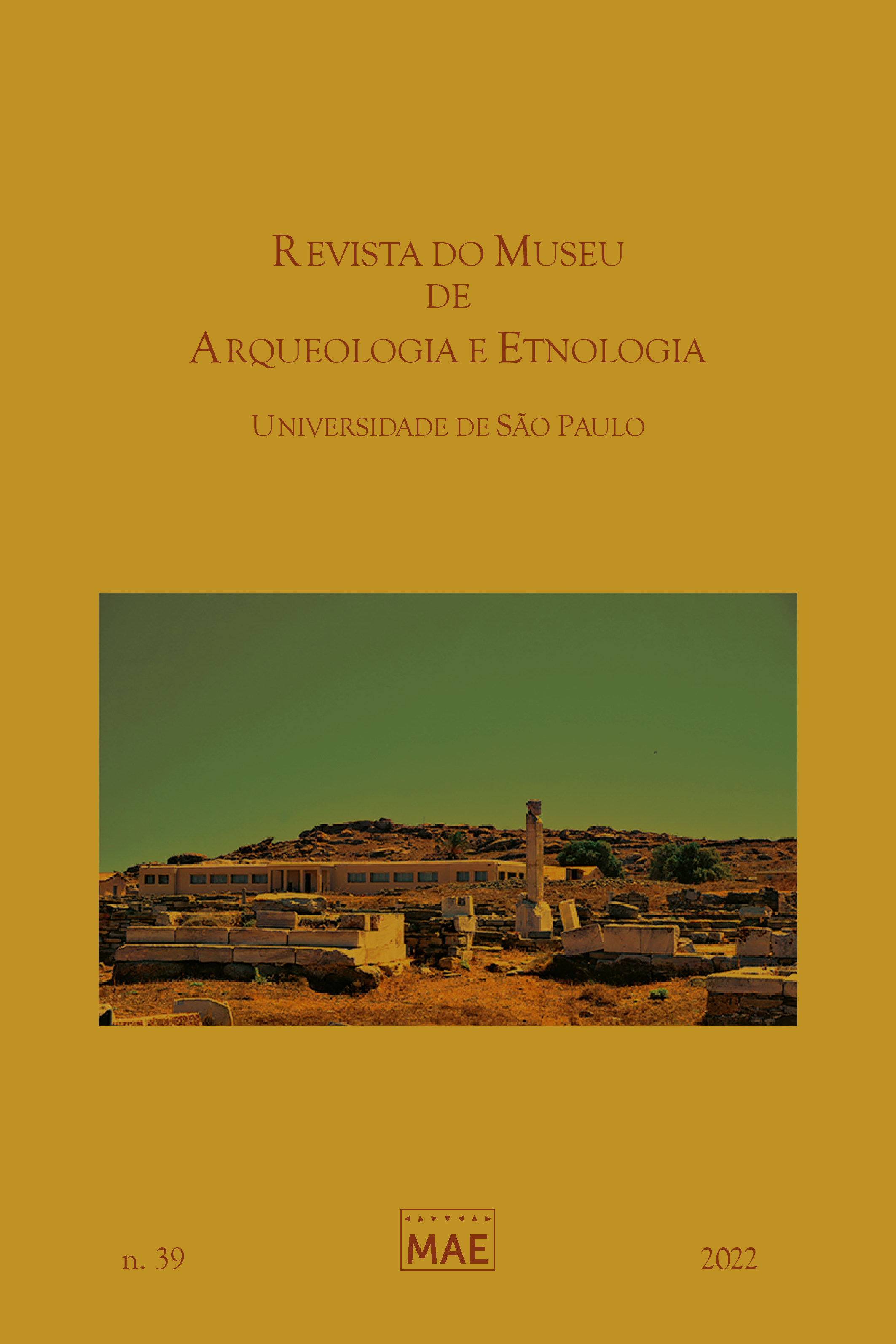"Our collections belong to you too": An analysis of the exhibition "Objects of Wonder" from the National Museum of Natural History
DOI:
https://doi.org/10.11606/issn.2448-1750.revmae.2022.188397Keywords:
Objects of Wonder;, Exhibition;, National Museum of Natural History;, Museum CommunicationAbstract
Who is the museum made for? This question can cause great debates within civil society, but how do museums approach this matter? The museum was created to be visited, to communicate with the public, and to be a place where there is an exchange of experiences. The museum must not only research and preserve, but also communicate such knowledge. Research carried out in a museum contributes to the development of human knowledge, but what is the real reach of this knowledge? Would he remain contained within the walls of the museum and the Academy? It is with this reach in mind that we place the exhibition “Objects of Wonder” from the National Museum of Natural History in Washington DC. Opened for visitation in 2017, this exhibition aims to show the visitor the origin and uses of objects that are part of the collections under the museum's care. Through thematic showcases, the exhibition introduces the visitor to the different departments of the museum and how knowledge is generated from these collections. This article analyzes this exhibition, from its structure to discourse, with special emphasis on the communicational function of museums.
Downloads
References
BENCHETRIT, Sarah Fassa. Os museus e a comunicação. In: MAGALHÃES, Aline Montenegro; BEZERRA, Rafael Zamorano; BENCHETRIT, Sarah Fassa (eds.). Museu e comunicação: exposições como objeto de estudo. Rio de Janeiro: Museu Histórico Nacional, 2010, p.11-15.
BERGERON, Yves. Los museos y la crisis: tendencias en los museos norteamericanos. Revista de la Subdirección General de Museos Estatales, n. 5-6, 2009-2010, p.58-67.
BOMBONATO, Rebeca Ribeiro. Duas leis, um museu: o caso do National Museum of the American Indian, o Native American Graves Protection and Repatriation Act e o National Museum of the American Indian Act. Revista de Arqueologia, v. 33, n. 3, p. 242–256, 2020.
CURY, Marília Xavier. Museus em transição. In: SISEM SP - Sistema Estadual de Museus. (Org.). Museus - O que são, para que servem? Bodowski: ACAM Portinari, Secretaria de Estado da Cultura de São Paulo, 2011, v. , p. 17-28.
CURY, Marília Xavier. Comunicação museológica: uma perspectiva teórica e metodológica de recepção. Tese de doutorado, Escola de Comunicação e Artes da Universidade de São Paulo, 2005.
DAVALLON, Jean. Comunicação e sociedade: pensar a concepção da exposição. In: MAGALHÃES, Aline Montenegro; BEZERRA, Rafael Zamorano; BENCHETRIT, Sarah Fassa (eds.). Museu e comunicação: exposições como objeto de estudo. Rio de Janeiro: Museu Histórico Nacional, 2010, p.16-34.
DIAS, Juliana Braz. Histórias contadas: análise de uma experiência entre os Anishinabe. Horizonte Antropológico, n 53, 2019, p.257-281
ESTADOS UNIDOS. Public Law 101-601 -Native American Graves Protection and Repatriation Act. Washington DC, Novembro 1990. Disponível em https://www.govinfo.gov/content/pkg/STATUTE-104/pdf/STATUTE-104-Pg3048.pdf. Acessado em 04/09/2020.
FERGUSON, Bruce W. Exhibition rhetorics: material speech and utter sense. GREENBERG, Reesa; FERGUSON, Bruce W.; NAIRNE, Sandy (eds.). Thinking about exhibitions. Routhledge: Londres, 1996.
HOOPER-GREENHILL, Eilean. Museums and their visitors. Routhledge: Londres, 1994.
KEENE, Suzanne. Fragments of the world: uses of museum collections. Elsevier Butterworth-Heinemann: Oxford, 2005
LIMA, Leilane Patricia de. A arqueologia e o patrimônio arqueológico indígena em exposições museais no centro-oeste de São Paulo e norte do Paraná: questões preliminares. In: CURY, Marília Xavier. Direitos indígenas no museu: novos procedimentos para uma nova política – a gestão de acervos em discussão. São Paulo: Secretaria da Cultura; ACAM Portinari; Museu de Arqueologia e Etnologia/USP, 2016. p. 115- 127.
LIMA, Leilane Patricia de. A comunicação em museus e a temática indígena em exposições: questões gerais e desafios atuais. In: CURY, Marília Xavier. Museus etnográficos e indígenas: aprofundando questões, reformulando ações. São Paulo: SEC; ACAM Portinari; MAE-USP, 2020. p. 201-218.
LIVNE, Inbal. Nature and culture in museums: an introduction. Journal of Museum Ethnography, n. 29, 2016, p.3-10.
McKEOWN, C.Timothy; HUTT, Sherry. In the smaller scope of conscience: the Native American Graves Protection & Repatriation Act twelve years after. UCLA Journal of Environmental Law and Policy, v.21, n.3, p. 153-212, 2003.
OBJECTS OF WONDER. Acessado em 15/06/2021. Disponível em <https://naturalhistory2.si.edu/vt3/NMNH/z_tour-146.html>.
OEHSER, Paul H.; HESKETT, Louise. The Smithsonian Institution. 2 ed. Routledge: Nova Iorque, 2019.
SHEETS-PYENSON, Susan.'Cathedrals of science: the development of colonial natural history museums during the late nineteenth century'. History of Science, n.25, 1986, pp. 279-300.
SMITHSONIAN INSTITUTION. A brief history of NMNH. Acessado em 23/06/2021a. Disponível em: <https://naturalhistory.si.edu/about>.
SMITHSONIAN INSTITUTION. Forensic Anthropology. Acessado em 23/06/2021b. Disponível em: <https://naturalhistory.si.edu/education/teaching-resources/written- bone/forensic-anthropology>.
WEIL, Stephen. Rethinking the museum and other meditations. Smithsonian Institution Press: Washington D.C, 1990, p. 57–61.
ZAVALA Lauro. La educación y los museos en una cultura del espetáculo. In: ENCUENTRO NACIONAL ICOM/CECA MÉXICO. La educación dentro del museo, nuestra propria educación, 2, 2001, Zacatecas, Memoria: ICOM México/CECA, 2003, p.19-31.
Downloads
Published
Issue
Section
License
Copyright (c) 2022 Rebeca Ribeiro Bombonato

This work is licensed under a Creative Commons Attribution-NonCommercial-NoDerivatives 4.0 International License.













